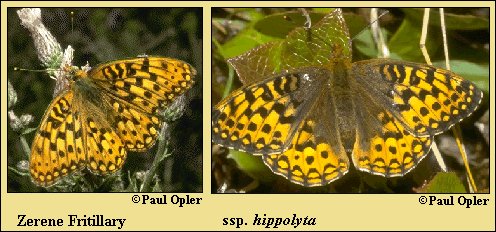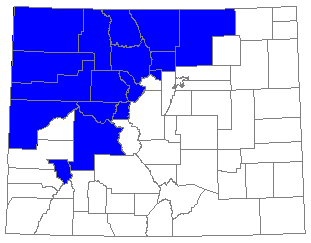 |
 

 |



Zerene Fritillary (Speyeria zerene [Boisduval])
Wing span: 2 1/8 - 2 3/4 inches (5.4 - 7 cm).
Identification: Upper surface of both wings tawny to red-brown with dark markings. Underside of hindwing has silvered or unsilvered marginal spots more triangular than those of Speyeria coronis.
Life history: Males patrol all day seeking females. Females may delay egg-laying until late summer. Eggs are laid on leaf litter near violets; unfed first-stage caterpillars overwinter on a silken mat. In the spring, caterpillars feed on leaves of violets.
Flight: One brood from mid-June to early September.
Caterpillar hosts: Violets including Viola adunca, V. lobata, V. cuneata, V. nuttallii, and V. purpurea.
Adult food:
Habitat: Conifer forests, sagebrush, coastal meadows and dunes.
Range: Coastal British Columbia south and east to Montana, south to central California, Arizona, and New Mexico.
Conservation:
The Oregon silverspot (subspecies hippolyta) is historically known from 17 locations along the Pacific Coast from southern Washington to central Oregon, but is now found in only 4 sites in Oregon. Habitat loss and intrusion of non-native plants have been accelerated by increased recreational use and development of the coast.
Speyeria zerene hippolyta is listed as T1 by The Nature Conservancy: Critically imperiled because of extreme rarity (5 or fewer occurrences, or very few remaining individuals), or because of some factor of its biology making it especially vulnerable to extinction. (Critically endangered throughout its range).
The Myrtle's silverspot (subspecies myrtleae) and Behren's silverspot (subspecies behrensii) are listed by the United States Fish and Wildlife Service.
Management needs: Establish Critical Habitat areas where encroaching development and plants can be managed to preserve meadows where the caterpillar host plant (Viola adunca) grows.
References:
Matthews, J. R., editor. 1990. The official World Wildlife Fund guide to
endangered species of North America, Vol. 2. Beacham Publishing, Inc.,
Washington, D. C. 636 pages.
Scott, J. A. 1986. The butterflies of North America. Stanford University Press,
Stanford, Calif. 583 pages, 64 color plates.
Tilden, J. W. 1986. A field guide to western butterflies. Houghton-Mifflin Co.,
Boston, Mass. 370 pages, 23 color plates.
Author: Jane M. Struttmann
State and Regional References:
Brown, F.M., Eff, J.D., and B. Rotger. 1957. Colorado Butterflies. Denver
Museum of Natural History, Denver.
Ferris, C.D. and F.M. Brown. 1980. Butterflies of the Rocky Mountain States.
University of Oklahoma Press. Norman.
Layberry, R.A., Hall, P.W. & Lafontaine, D.J., 1998. The Butterflies of
Canada. University of Toronto Press, Toronto, ON. 280 pp.
Opler, Paul A. 1999. Peterson Field Guide to Western Butterflies, revised
edition. Houghton Mifflin Co., Boston, Mass.
Stanford, R.E. and P.A. Opler. 1993. Atlas of Western USA Butterflies.
Privately published, Denver, Colo.
Tilden, J.W. and A.C. Smith. 1986. A Field Guide to Western Butterflies.
Houghton Mifflin Co., Boston, Mass.

